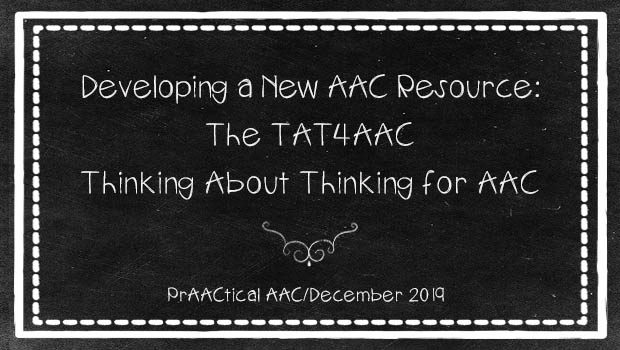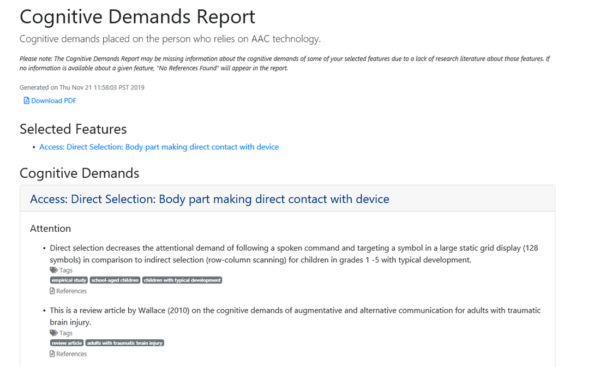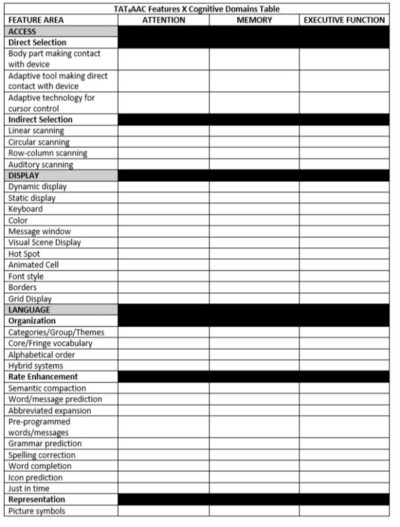Developing a New AAC Resource: The TAT4AAC (Thinking About Thinking for AAC)

How do you consider the cognitive demands of using an AAC system when making recommendations and planning instruction? Today, we feature a wonderful new tool developed at the Oregon Health and Science University (OHSU). Join us as we learn about the TAT4AAC team and their efforts to create an instrument that helps us think through these complex issues.
The TAT4AAC was designed by members of the REKNEW team at OHSU) in Portland, OR, USA. The team is under the direction of Melanie Fried-Oken, an SLP, AAC specialist and professor at OHSU. Melanie leads the REKNEW team. Aimee Mooney, the project team leader, is an SLP and assistant professor at OHSU. She specializes in cognitive rehabilitation. Michelle Kinsella, an OT with a specialty in vision and cognition, in another member of the team along with Deirdre McLaughlin, an SLP with a passion for AAC and young kids.
Developing a New AAC resource: The TAT4AAC
(Thinking About Thinking for AAC)
We all know that cognitive demands are placed on us by our everyday technology. When we buy groceries and want to pay with a credit card, we are asked to swipe our card or to place the card in a chip reader. Some store devices want us to sign with a finger, or sign with a stylus or just don’t sign at all. Each machine is slightly different and requires us to problem solve or follow directions or understand the process. I recently bought a new car and had to shift (reluctantly) from a key to the keyless fob; even the requirements for turning on the car have cognitive demands! We must learn the operations of each technology and the new demands that are placed on us for effective use.
The cognitive demands of technologies are present in each AAC device, as well. Consider for a moment the person who needs to use switch scanning for typing. She must attend to a cursor moving on the screen and each letter, while simultaneously remembering the answer to the question posed to her and how to spell the response. The attention, memory and executive function demands placed on the user for just providing a one-word response are huge in this situation. Or consider the visual cognitive demands placed on a child who is learning to use tablet with a visual scene display and navigation bar on the top. We must examine what cognitive demands are placed on the user by AAC technology, and we must factor those cognitive demands into device design, device prescriptions, treatment and implementation.
In 2014, the REKNEW lab at Oregon Health & Science University, a partner of the NIDILRR-funded Rehabilitation Engineering Research Center on Augmentative and Alternative Communication (RERC on AAC), took on the challenge of developing a website that would help AAC providers, designers, and consumers consider these cognitive demands. We called the website TAT4AAC: Thinking about Thinking for AAC. Below I describe the 6 steps that went into creation of the website.

Pictured are, from left to right: Melanie Fried-Oken, Aimee Mooney, and Michelle Kinsella. Not pictured: Deirdre McLaughlin
Step 1: We began the project by examining the feature lists that were available for AAC devices and software/apps. We asked: What AAC features should we include in this new reference tool? We started with four feature categories: Access, Display, Language and Output, and then placed 54 AAC device/app features within these four categories. We validated this feature list nationally, asking AAC clinicians, users and developers to confirm our framework.
Step 2: We examined the cognitive skills that are critical to AAC devices. We chose to focus on three cognitive skills: attention, memory, and executive function. We validated these selections through a consensus process with national cognition experts.
Step 3: With a framework in place to examine cognitive demands of each AAC feature, we delved into the current research literature. We conducted a literature review using the following guidelines: (1) Use the key words attention, memory, executive function + designated AAC feature (i.e., memory + AAC direct selection); (2) Only use literature from the past 10 years (unless seminal article); (3) Each article is read independently by 2 research associates who agree on inclusion in the TAT4AAC interactive library; (4) A summary is written for each article following strict rules so that the annotation is consistent throughout the website. Articles are tagged as either theoretical or empirical, for adult or child populations. A total of 68 articles are included in the final website.
Step 4: We worked with a website designer to develop an interactive library and final product. When we had finished the first version, we presented it to 70 stakeholders (AAC clinicians; educators; cognitive rehabilitation clinicians; AAC developers and technologists; people who rely on AAC and their parents or spouses; researchers). Our second and even third iterations of the website were based on their responses and recommendations.
Step 5: It was very important to us that potential TAT4AAC users understand the purpose of this tool and how it was developed. We spent a lot of time designing the home page, our mission statement and the development process. It was developed to (1) provide references about the cognitive demands of specific features of AAC technologies and (2) provide opportunities for clinicians to consider and compare the cognitive demands of AAC technologies.
We are clear that the TAT4AAC is:
- NOT an assessment tool.
- NOT a prerequisite list of cognitive skills needed before AAC technology is introduced.
- NOT a list to determine eligibility for potential device trial, purchase or training.
- NOT a list of cognitive skills needed before device trialing or purchase.
- NOT a base to eliminate AAC options for individuals who may rely on AAC technologies.

Step 6: The TAT4AAC website went live on Tuesday, November 12. We started sending out links to our colleagues, listservs, websites, and any interested parties we could think of. Carole Zangari asked us to share it with you here. We hope you find this new resource as innovative, useful and important as we do: tat4aac.ohsu.edu .



Filed under: Featured Posts, PrAACtical Thinking
Tagged With: AAC decision-making, cognition
This post was written by Carole Zangari



2 Comments
Hi there, I would like to subscribe for
this blog to take most recent updates, thus where can i do it please help out.
AMAZING!!!!! This is so necessary in the AAC assessment community